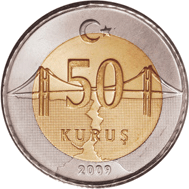Kuruş
Kuruş, also Qirsh, Ersh, Gersh, Grush and Grosi, are all names for currency denominations in and around the territories formerly part of the Ottoman Empire. The variation in the name stems from the different languages it is used in (Arabic, Amharic, Hebrew, Turkish and Greek) and the different transcriptions into the Latin alphabet. In European languages, the kuruş was known as the piastre.

The kuruş (pl. kuruşlar) is a Turkish currency subunit. The kuruş was also the standard unit of currency in the Ottoman Empire until the 1844 subdivision of the former Ottoman gold lira. It was subdivided into 40 para or 120 akçe. Since 2005, one Turkish lira is equal to 100 kuruş.
Name
The Turkish word kuruş (Ottoman Turkish: قروش, kurûş; Greek: γρόσι, grosi; plural γρόσια, grosia; or grosha)[1] is derived from the French gros ("heavy"). It is cognate with the German groschen and Hungarian garas.
The name of the Groschen (Latin: Grossus, German: Groschen, Italian: grossone, Czech: groš, Polish: grosz, Hungarian: garas, Romanian: groș), a coin used in various German-speaking states as well as some non-German-speaking countries of Central Europe (Bohemia, Poland, the Romanian principalities), is derived from the same origin of the Italian denaro grosso.
The name originally comes from the Italian grosso, as in denaro grosso, a silver coin worth twelve denari.
History
The kuruş was introduced in 1688. It was initially a large silver piece (similar to the European thalers issued by the Ottomans), approximately equal to the French écu, or, from other sources, to the Spanish dollar. It was worth 40 para. In 1844, following sustained debasement, the gold lira was introduced, worth 100 qirsh. During the late 18th to early 19th centuries it was further reduced to a billon coin weighing less than 3 grams.
As the Ottoman Empire broke up, several successor states retained the qirsh as a denomination. These included Egypt, Saudi Arabia, Syria, Lebanon and Turkey itself. Others, including Jordan and Sudan, adopted the qirsh as a denomination when they established their own currencies.
At the beginning of the 19th century, silver coins were in circulation for 1 akçe, 1, 5, 10 and 20 para, 1, 2 and 2 1⁄2 kuruş, together with gold coins denominated in zeri mahbub and altin. As the silver coins were debased, other denominations appeared: 30 para, 1 1⁄2, 3, 5 and 6 kuruş. The final coinage issued before the currency reform consisted of billon 1, 10 and 20 para, and silver 1 1⁄2, 3 and 6 kuruş.
In 1844, the Turkish gold lira was introduced as the new standard denomination. It was divided into 100 silver kuruş and the kuruş continued to circulate until the 1970s.
Kuruş eventually became obsolete due to the chronic inflation in Turkey in the late 1970s. A currency reform on 1 January 2005 provided its return as 1⁄100 of the new lira.
See also
References
Bibliography
- Krause, Chester L.; Clifford Mishler (1991). Standard Catalog of World Coins: 1801–1991 (18th ed.). Krause Publications. ISBN 0873411501.
External links
- http://www.osmanliparalari.com Everything about Ottoman coins (in Turkish)
- 50 Kuruş Banknote
- Ottoman Empire coins